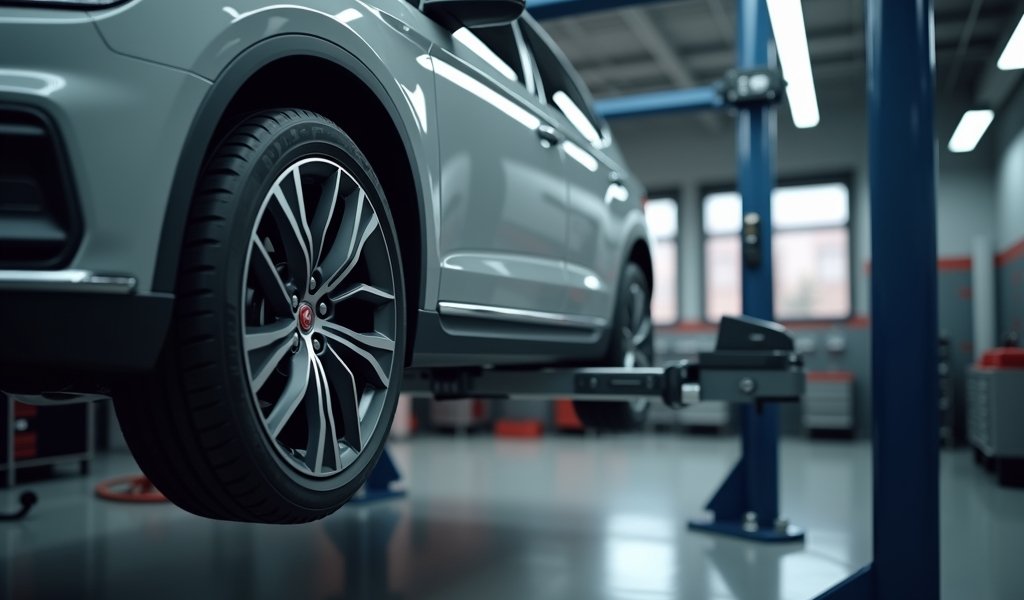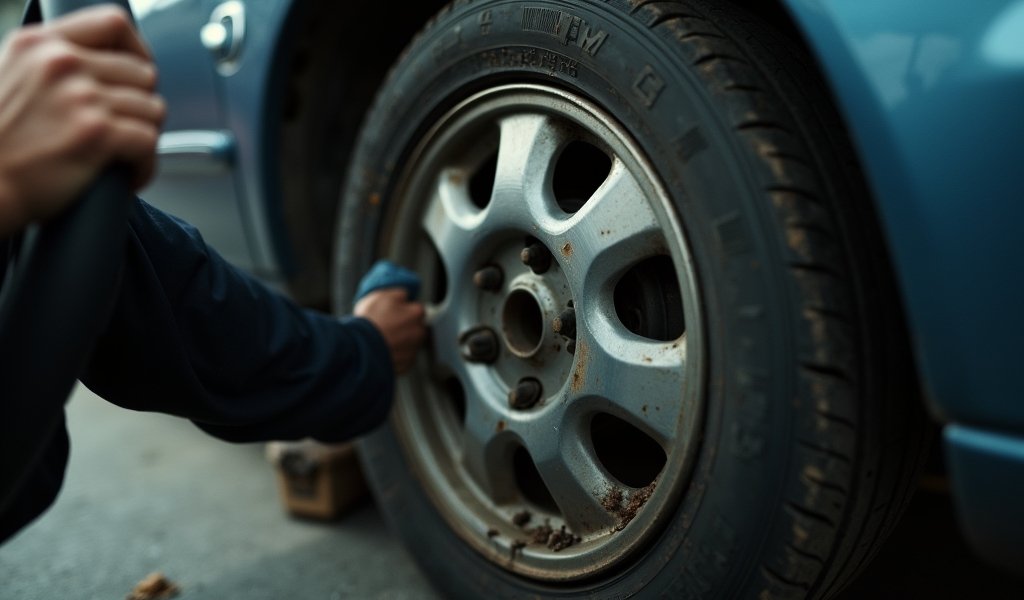Overview
This article provides five essential tips for proper wheel balancing weight placement, including choosing between clip-on and adhesive weights, mastering weight distribution techniques, accounting for wheel design variations, following correct installation procedures, and performing regular balance checks. The article emphasizes that proper wheel balancing is crucial for preventing premature tire wear, improving fuel efficiency, ensuring safer handling, and extending the life of suspension components.
Table of Contents
- Understanding Wheel Balancing: Why Proper Weight Placement Matters
- Common Issues Caused by Improper Wheel Balance
- Tip 1: Master the Clip-On vs. Adhesive Weight Decision
- Tip 2: Perfect Your Weight Distribution Technique
- Tip 3: Account for Wheel Design Variations
- Tip 4: Follow Proper Weight Installation Procedures
- Tip 5: Perform Regular Balance Checks
- DIY vs. Professional Wheel Balancing: Making the Right Choice
- Conclusion
- Frequently Asked Questions
Understanding Wheel Balancing: Why Proper Weight Placement Matters
Wheel balancing weight placement is one of those seemingly small details that can make a world of difference in your driving experience. As a mechanic who’s balanced thousands of wheels over two decades, I can tell you firsthand that proper weight placement isn’t just about eliminating that annoying steering wheel vibration—it’s about extending the life of your tires, improving fuel efficiency, and ensuring safer handling on the road.
Think of your wheels as the foundation of your vehicle’s performance. Even the slightest imbalance—we’re talking fractions of an ounce—can create noticeable vibrations at highway speeds. These vibrations aren’t just uncomfortable; they’re actively wearing down your suspension components, wheel bearings, and tires in ways that might not be immediately obvious.
The art of wheel balancing involves strategically placing small weights on your wheel to counteract these natural imbalances. It’s a precise science that requires understanding both the physics involved and the specific characteristics of modern wheels. Let’s dive into why getting this right matters so much for your vehicle’s health and your driving comfort.
Common Issues Caused by Improper Wheel Balance
Before we jump into the tips, it’s worth understanding what happens when wheel balancing goes wrong. I’ve seen countless vehicles roll into my shop with issues that could have been prevented with proper balancing.
Premature tire wear is perhaps the most common and costly consequence. When weights aren’t placed correctly, certain sections of your tire take more punishment than others. This uneven wear pattern can reduce a tire’s lifespan by thousands of miles, forcing you to replace tires long before you should need to.
Then there’s the issue of handling. Poorly balanced wheels affect how your car responds to steering inputs, especially during emergency maneuvers. This isn’t just about comfort—it’s a genuine safety concern that shouldn’t be overlooked.
Many drivers also don’t realize that vibrations from improper balancing transfer through the entire vehicle, potentially loosening components over time. I’ve seen everything from prematurely worn wheel bearing hub assemblies to steering rack damage that stemmed from long-term wheel imbalance issues.
Fuel economy suffers too. Your engine has to work harder to overcome the resistance created by imbalanced wheels, which translates directly to more frequent stops at the gas station. It might seem minor at first, but these efficiency losses add up significantly over time.

Tip 1: Master the Clip-On vs. Adhesive Weight Decision
The first critical decision in wheel balancing weight placement is choosing between clip-on and adhesive weights. This isn’t just about what looks better—it’s about what works best for your specific wheel design.
Clip-on weights have been the traditional go-to for steel wheels. They hook securely onto the inner or outer lip of the wheel, providing a reliable hold that withstands the centrifugal forces generated during driving. These weights are generally less expensive and easier to install, which makes them popular in many repair shops.
However, adhesive weights are essential for modern alloy wheels, especially those with complex designs or where clip-on weights simply won’t fit. According to research from the Tire Industry Association, adhesive weights provide more precise balancing for today’s lighter alloy wheels, resulting in smoother performance at high speeds.
Here’s what I recommend based on wheel type:
- Steel wheels: Clip-on weights work perfectly well in most cases
- Standard alloy wheels: Either type can work, though adhesive often provides better results
- Premium/custom alloy wheels: Always use adhesive weights to prevent damage to the wheel finish
- Wheels with spoke designs that extend to the rim: Adhesive weights are your only viable option
Remember that mixing weight types isn’t ideal but can sometimes be necessary for complex balancing situations. The goal is to achieve proper balance while minimizing the total weight added to the wheel—less weight means better efficiency and performance.
Tip 2: Perfect Your Weight Distribution Technique
The placement of balancing weights isn’t random—it follows specific principles that ensure optimal results. The key concept here is counterbalance: weights should be positioned to directly offset the natural heavy spots in your wheel and tire combination.
Modern wheel balancers make this process much more precise than the old days of “eyeballing it.” These machines analyze the wheel’s rotation and calculate exactly where weights should go and how heavy they should be. Still, there’s a technique to applying this information correctly.
For dual-plane balancing (the most common method), you’ll typically place weights in two locations:
- Inner weights: Positioned on the inner lip of the wheel (for clip-ons) or the inner barrel (for adhesives)
- Outer weights: Placed on the outer edge or face of the wheel, depending on design
The distribution between these locations matters tremendously. If your balancer calls for 0.5 oz on the inner plane and 0.25 oz on the outer, don’t try to simplify by putting 0.75 oz in one location. This approach might seem more efficient, but it fails to address both static (up-and-down) and dynamic (side-to-side) imbalances.
When using multiple weights on a single plane, try to keep them within 90 degrees of each other when possible. Spreading weights too far apart can create new imbalance issues that your balancer wasn’t accounting for. This is especially important when using larger weights, which have more potential to cause problems if improperly placed.
Professional mechanics use a technique called “weight matching” where they’ll choose the optimal combination of available weight sizes to match the balancer’s recommendation exactly. This attention to detail makes a noticeable difference in the final result.
Tip 3: Account for Wheel Design Variations
Not all wheels are created equal, and wheel balancing weight placement must adapt to the specific design you’re working with. This is particularly relevant for performance, luxury, or custom wheels where aesthetics are as important as function.
For wheels with exposed outer faces where weights would be visible, the “hidden weight” placement technique can be your best friend. This involves placing all weights on the inner barrel of the wheel, keeping the outer face clean and sleek. While this sometimes requires more total weight to achieve balance, the aesthetic improvement is worth it for many enthusiasts.
Wheels with unusual profiles present their own challenges. Some modern “aero” wheels have a completely flat face to reduce drag, offering limited surface area for adhesive weights. In these cases, you may need to use specialized low-profile weights or place weights in alternative positions recommended by the wheel manufacturer.
When working with larger wheel and tire combinations, pay special attention to the wheel offset calculations and how they affect weight placement. Wheels with extreme offsets often develop unique balance characteristics that require more careful weight distribution to avoid vibration issues at specific speed ranges.
For custom or rare wheels, I always recommend consulting the manufacturer’s specifications before balancing. Some high-end wheel makers provide detailed balancing instructions that differ from standard procedures—ignoring these can lead to suboptimal results or even wheel damage in extreme cases.

Tip 4: Follow Proper Weight Installation Procedures
Even the most precisely calculated wheel balancing weight placement can fail if installation procedures aren’t followed correctly. Over the years, I’ve seen countless balance jobs go wrong simply because of poor installation technique.
For clip-on weights, secure installation starts with properly positioning the weight at the exact point indicated by your balancer. The clip should fit snugly against the wheel rim with no wobble or movement. Use a proper installation tool rather than a hammer—this prevents damage to both the weight and your wheel.
When working with adhesive weights, surface preparation is absolutely critical. The area must be thoroughly cleaned with an appropriate solvent to remove all traces of dirt, brake dust, and oils. SAE research indicates that up to 60% of adhesive weight failures occur due to inadequate surface preparation.
Here’s my step-by-step process for adhesive weight installation:
- Clean the mounting surface thoroughly with brake cleaner or isopropyl alcohol
- Allow the surface to dry completely (usually 30-60 seconds)
- Remove the backing from the weight without touching the adhesive surface
- Position the weight precisely at the marked location
- Press firmly from the center outward to eliminate air bubbles
- Apply steady pressure for 10-15 seconds to ensure proper adhesion
Temperature matters too—adhesive weights don’t bond well in cold environments. If you’re working in temperatures below 50°F (10°C), consider warming the wheel surface slightly before applying weights. A heat gun on its lowest setting can work wonders for adhesion in cold workshop conditions.
Finally, always verify your work with a spin test after installation. This catches any weights that might not be securely attached before they become a problem on the road.
Tip 5: Perform Regular Balance Checks
The final tip in mastering wheel balancing weight placement is understanding that it’s not a “set it and forget it” procedure. Regular balance checks should be part of your vehicle maintenance routine, especially after significant events that might affect wheel balance.
I recommend checking your wheel balance in the following situations:
- After hitting a significant pothole or road hazard
- When rotating tires (every 5,000-7,000 miles)
- If you notice new vibrations at certain speeds
- When replacing tires
- Seasonally, especially if you switch between summer and winter tires
- If you notice a wheel weight has fallen off
Modern tires can actually change their balance characteristics over time. As tread wears, the weight distribution of the tire changes gradually. What was perfectly balanced at installation might develop slight imbalances after several thousand miles of normal use.
During these check-ups, pay attention to the condition of existing weights. Clip-on weights can loosen over time, especially on vehicles that see rough road conditions. Adhesive weights can sometimes peel at the edges after exposure to extreme temperatures or harsh cleaning chemicals.
If you find yourself needing to add more weight to wheels that were recently balanced, this could indicate a deeper issue. Bent wheels, separated tire belts, or developing flat spots might be the culprit rather than a simple balance issue. In these cases, a more thorough inspection is warranted.
DIY vs. Professional Wheel Balancing: Making the Right Choice
While understanding wheel balancing weight placement principles is valuable knowledge for any vehicle owner, there’s an important decision to make: should you attempt to balance your wheels yourself or leave it to professionals?
DIY wheel balancing is certainly possible with static balancers available for home use. These tools can help address basic imbalance issues, but they only correct static (up-and-down) imbalance—not the dynamic (side-to-side) imbalance that causes many vibration problems at highway speeds.
Professional shops use sophisticated dynamic balancers that measure imbalance in multiple planes. These machines, which often cost several thousand dollars, can detect imbalances as small as 0.1 ounce and provide precise placement instructions that are difficult to replicate with home equipment.
The cost factor is worth considering too. Professional wheel balancing typically costs $10-20 per wheel, which represents excellent value considering the specialized equipment and expertise involved. DIY solutions might save money initially but can lead to more expensive problems if done incorrectly.
My recommendation? Unless you’re a dedicated enthusiast with proper equipment, professional balancing is the wiser choice for most drivers. The precision of modern computerized balancers, combined with a technician’s experience in proper weight placement, typically delivers superior results that improve both driving comfort and long-term vehicle health.
Conclusion
Proper wheel balancing weight placement is much more than a minor maintenance detail—it’s an essential aspect of vehicle performance that affects everything from ride comfort to tire longevity. By understanding the five key tips we’ve covered, you’ll be better equipped to maintain your vehicle and communicate effectively with your mechanic.
Remember that wheel balance is a dynamic aspect of your vehicle that changes over time. Regular checks, especially after significant events like hitting potholes or tire rotations, help ensure consistent performance and prevent premature wear of suspension components.
Whether you’re a DIY enthusiast learning to balance your own wheels or someone who relies on professional service, understanding these principles helps you make informed decisions about your vehicle’s care. The small attention to detail in proper wheel balancing weight placement pays dividends in a smoother, safer, and more efficient driving experience.
Next time you feel that telltale steering wheel vibration at highway speeds, you’ll know exactly what’s happening—and more importantly, how to address it correctly. Your tires, suspension, and wallet will all thank you for paying attention to this crucial aspect of vehicle maintenance.
Frequently Asked Questions
How much does improper wheel balancing affect tire wear?
Improper wheel balancing can reduce tire lifespan by 25-30%. Uneven wear patterns develop quickly, especially at highway speeds where imbalance forces are magnified.
Can I drive with unbalanced wheels?
While technically possible, driving with unbalanced wheels accelerates tire and suspension wear and compromises handling. It’s unsafe for long-term driving, especially at highway speeds.
How often should wheels be balanced?
Wheels should be balanced when installing new tires, during regular rotation (every 5,000-7,000 miles), and whenever you experience vibrations. Additional checks after hitting major potholes are also recommended.
Why do wheel weights sometimes fall off?
Wheel weights can fall off due to improper installation, surface contamination (for adhesive weights), or impact with road hazards. Extreme temperature changes and harsh cleaning chemicals can also compromise adhesive bonds.
Can I balance my wheels at home?
Home balancing is possible with static balancers but lacks the precision of professional dynamic balancing equipment. DIY methods are better for minor adjustments than complete balancing jobs.

